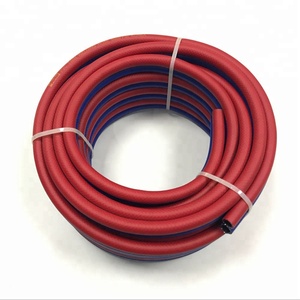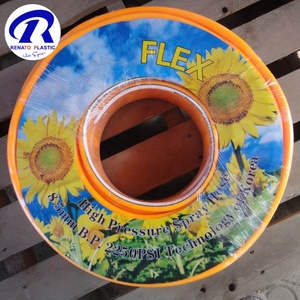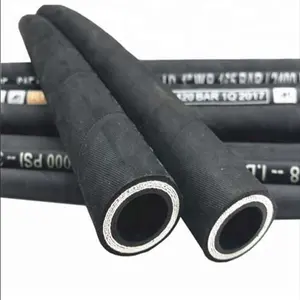(39609 products available)














































































































































































An air flexible hose is a tube that carries air, fluids, or gas. It is flexible and can bend into different positions. A flexible hose is lightweight, easy to handle, and widely used in various applications. The types of air flexible hoses are as follows:
Spiral Hoses
A spiral hose is a flexible air hose with a spiral wire inside that helps it expand and contract smoothly. It's great for applications that need freedom of movement, like on construction sites or in factories where machines move around a lot. The design makes it durable and able to handle different pressures and temperatures. It's used in industrial equipment, agricultural machinery, and any place where a flexible yet robust air hose is needed.
Coiled Air Hoses
A coiled air hose is a flexible air tool that automatically returns to its original shape after being stretched. Its coil design helps it stay organized and not get twisted when used. This hose is great for tools that work continuously without the user having to deal with a messy, tangled line. It's commonly seen in workshops, garages, and areas where compressed air tools are used. The coiled air hose makes working with pneumatic tools easier and cleaner.
Reinforced Hoses
Reinforced hoses are air flexible hoses with multiple layers and embedded materials like nylon or polyester mesh. This gives them extra strength while remaining lightweight and flexible. These hoses are perfect for applications that need high pressure without bursting or kinking. They work well in pneumatic systems, irrigation setups, and anywhere that needs water, air, or gas without pressure loss. Their reinforcement makes them a reliable choice for many tasks.
Rubber Air Hoses
These hoses are made of rubber, which makes them strong and flexible. They're great for tasks needing air and can be used outside without getting damaged by the sun or other things. Unlike other hoses that might get stiff in the cold, rubber air hoses stay flexible. They're widely used in workshops, for airbrushing, and in any place where air needs to be moved efficiently. Rubber air hoses are dependable for both professional and DIY tasks.
Thermoplastic Air Hoses
These hoses are made from thermoplastic materials, making them lightweight and easy to work with. They're less likely to get tangled and more robust than rubber hoses. Thermoplastic air hoses are excellent for specific air tasks, especially in colder climates where rubber might get stiff. They're often used in HVAC systems, medical facilities, and places where cleanliness and low weight are essential. Their versatility makes them a popular choice for air transmission.
The flexible air hose provides a means of transferring compressed air to different tools and applications. The flexible air hoses can bend around corners, can be routed through tight spaces, and can be positioned to reach various areas. They are lightweight and portable, making them easy to carry and move from one location to another. They are also designed to reduce noise, and their flexibility helps minimize vibration transmission. Flexible air hoses are designed to be resistant to wear, cuts, and abrasion, and they offer a longer service life. They are designed for ease of use, and their flexibility improves efficiency and productivity.
Features of air flexible hoses include:
Air flexible hoses are used in a wide range of applications across different industries due to their lightweight, flexible, and durable characteristics. Here are some common usage scenarios:
Automotive Industry
Flexible air hoses are commonly used in workshops and garages for pneumatic tools such as; impact wrenches, air ratchets, nail guns, and spray guns. These hoses provide a flexible connection between the air compressor and the tools, allowing easy movement and reducing friction in static lines.
Construction Industry
Construction sites use air flexible hoses to power various pneumatic equipment, including jackhammers, air chisels, nailers, and staplers. The flexibility of these hoses enables workers to maneuver around obstacles and reach tight spaces.
Manufacturing Industry
In manufacturing facilities, air flexible hoses are used in conveyor systems, robotic arms, and automated machinery. The hoses facilitate the movement of compressed air to operate cylinders, grippers, and other pneumatic components.
HVAC Systems
Flexible air conditioning hoses are used in the HVAC industry to transport air from ductwork to various components, such as; vents, registers, and air intake. The flexibility of these hoses allows for easy installation and connection in tight spaces.
Agriculture
Farmers often use air flexible hoses with pneumatic tools for equipment maintenance and repairs. Additionally, these hoses can be used to operate pneumatic systems in agricultural machinery, such as; planters, sprayers, and harvesters.
Marine Applications
Flexible air hoses are commonly used in boats and ships for various applications, including; powering pneumatic tools, controlling marine equipment, and operating air-conditioned systems. These hoses are preferred because of their lightweight and flexibility, which is important in confined spaces and areas with limited movement.
DIY Projects
Flexible air hoses are commonly used for DIY projects in workshops and home garages. They provide an air source for various tools, including; airbrushes, tire inflators, and handheld pneumatic tools. The flexibility and lightweight nature of these hoses make them easy to use and store when working on different projects.
Medical Equipment
Air flexible hoses are used in the medical field to transport compressed air to various medical devices and equipment. These devices include; nebulizers, oxygen concentrators, and suction machines. The lightweight and flexible nature of the hose makes it easy to handle and transport in a clinical setting.
When choosing the air flexible hose for sale, it is important to consider certain factors to ensure a reliable and suitable product is selected. Here are some key factors to take into account:
Application Requirements
Business owners should consider the specific application needs. This includes the working pressure, temperature range, and the type of medium that will flow through the hose. They should ensure that the air flexible hose meets these requirements.
Materials
It is important to consider the different materials used to manufacture air flexible hoses. These materials include PVC, rubber, and polyurethane. Each material has its own advantages. For instance, some are more durable and weather resistant than others. Choose a material that is best suitable for the intended application.
Diameter and Length
Another factor to consider is the diameter and length of the hose. Business owners should determine the required diameter to ensure optimal airflow and minimal pressure loss. They should also consider the ideal length of the hose to avoid excess material that can restrict airflow.
Compatibility
It is also important to check the compatibility of the air hose with different fittings and connectors. This ensures a secure and leak-proof connection.
Flexibility and Bend Radius
Buyers should consider the flexibility of the hose, especially if it will be used in applications that require frequent movement. They should also look for a hose with a small bend radius.
Brand Reputation
Business owners should purchase air flexible hoses from reputable brands. They can read reviews and testimonials to get more insight into the product quality and performance.
Certifications and Standards
To ensure safety and reliability, buyers should select air flexible hoses that comply with industry standards and certifications. This shows that the product has been tested and it meets the required guidelines.
Q1: What are the most common applications of air flexible hoses?
A1: Flexible hoses for air are used in various applications. These applications include connecting air compressors to pneumatic tools, power machinery and equipment, air conditioning and refrigeration systems, brake systems in automobiles, fuel lines, and oil transfer in vehicles and machinery. Air flexible hoses are also used in agricultural equipment, construction machinery, and industrial applications.
Q2: What factors should be considered when choosing an air flexible hose?
A2: Several factors should be considered when choosing an air flexible hose. These factors include the type of air compressor hose, the diameter of the hose, working pressure, temperature rating, compatibility of the fluid, flexibility and bend radius, length of the hose, and fittings and connections.
Q3: Can air flexible hoses be customized?
A3: Yes, air flexible hoses can be customized. Customization depends on the application requirements. Some manufacturers offer customization options. These options include selecting the material, length of the hose, diameter of the hose, and type of fittings.
Q4: Are air flexible hoses durable?
A4: Yes, air flexible hoses are durable. They are designed to withstand harsh environments and conditions. These hoses offer repeated flexing and bending. Their durability depends on the construction material, application, and proper use.
Q5: Do air flexible hoses require maintenance?
A5: Yes, air flexible hoses require maintenance. Regular maintenance ensures the hoses function correctly. It also ensures they have a long lifespan. Basic maintenance involves inspecting the hoses, cleaning them, and replacing worn-out parts.
The web search volume for the keyword "air flexible hose" in the Rubber & Plastics category reveals a monthly average of 20 web searches, with significant fluctuations over the past year. Notably, there has been a substantial three-month decrease of 67% in web search volume, despite a stable one-year change of 0%. Over the past 12 months, the data shows a pattern of peaks and valleys, with web search volumes varying between 10 and 30.
Delving deeper into the monthly search data, we observe that the web search volume for "air flexible hose" peaked in September 2024 at 30 web searches, indicating a temporary spike in interest or demand. However, this was followed by a return to lower web search volumes of 10 in the subsequent month of October 2024. The fluctuations suggest a seasonal variation, with higher web searches in April, August, and September, and significantly lower volumes in other months.
The observed trends in web search volume for "air flexible hose" highlight a pattern of variability, with notable peaks interspersed with substantial declines. This pattern could be influenced by various factors, including market demand cycles, seasonal usage changes, or shifts in related industries. However, without further data, the exact reasons for these fluctuations remain speculative. The analysis of these trends provides valuable insights into the keyword's performance and can guide strategic business decisions related to marketing and inventory management in the Rubber & Plastics sector.